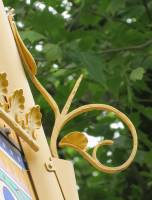
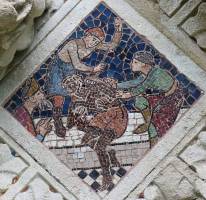
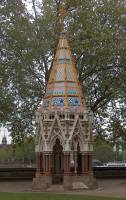
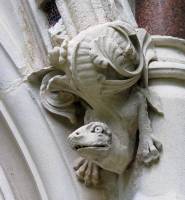
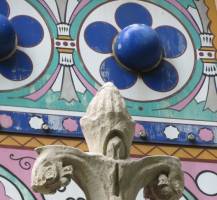
The Buxton Memorial Fountain is a perfect little Victorian Gothic shrine, situated next to the Houses of Parliament in the small riverside open space called Victoria Tower Gardens. It is of interest here for its artwork: indeed, it is an example of how the Victorians sought the Renaissance ideal, combining many arts in one complete creation: we have in the Buxton Memorial a work combining mosaic, tile, sculpture, different coloured marbles, and serious Gothic architecture including vaulting. And all on a base just 12 ft wide.
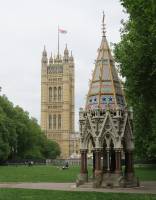 Buxton Memorial Fountain, Victoria tower in background.
Buxton Memorial Fountain, Victoria tower in background.
The Buxton Memorial Fountain was erected by the MP Charles Buxton, in memory of his father, Sir Thomas Fowell Buxton, and, so the stone panel on one side notes, those others associated with him who fought against slavery: ‘Wilberforce, Clarkson, Macaulay, Brougham, Dr Lushington, and others’. Their ultimate success was the Slavery Abolition Act of 1833, and the emancipation of slaves which followed in 1834 is commemorated on the plaque. The panel also says that the fountain was erected in 1835, but this is obviously wildly incorrect for what is a seriously High Victorian construction. The date is in fact 1865. The architect was the Victorian church designer, Samuel S. Teulon, but Charles Buxton was himself an amateur architect of distinction, and the work is a collaboration between the two: I am inclined to think the overall architectural structure is Teulon’s, as he was a forceful and distinctive Gothicist architect, and Buxton’s efforts would have been more in the detail: perhaps the mosaics, and the designs on the spire. It is not quite complete: there were eight small bronze statues, whose bases can still be seen, but these were stolen – see further down the page.
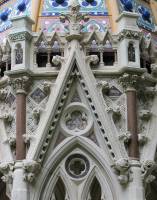
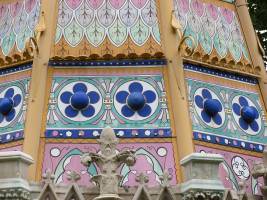 Bases to the statues, and detailing of roof decoration.
Bases to the statues, and detailing of roof decoration.
The Buxton Memorial Fountain originally stood in Parliament Square, but with the redesign of the Square before the Festival of Britain, the fountain was taken down at the end of the 1940s, and put up in Victoria Tower Gardens – only a couple of hundred yards away – in 1957. The Parliamentary debates of the time – all available in the Hansard record from the Parliamentary website, give an interesting account of the reasons for and against the move and the feelings towards Victorian art at the time.
Those seeking to keep the Buxton Fountain in Parliament Square felt it unfair that the statues in the Square were allowed to stay, but the Fountain was singled out for removal, and keenly felt the historical symbolism and significance of the piece: that a monument to the abolition of slavery really should be in Parliament Square, with its other symbols of democratic struggle (which continue to this day with the recent erection of statues of Mandela and Gandhi). Other reasons given in the debates before and around the passage of the Bill to redesign the Square were more esoteric:
The Bishop of Lichfield noted that he himself was related to ‘that clan of Buxtons and Barclays and Hoares and Gurneys’, and on behalf of the clan, said that ‘Families and relatives have a natural dislike to having their tombstones and memorials moved about hither and thither’ and the monument should stay.
Viscount Bledisloe, one-time proconsul for New Zealand, said he ‘could imagine nothing that would more profoundly shock the people of all classes and all political Parties in the Dominion of New Zealand...if it were to to go out that the memorial to Fowell Buxton, one of the great English champions of freedom, was to be removed from the place where alone it ought to be, in the precincts of this Parliament.’
Details of the sculptural decoration.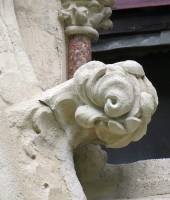
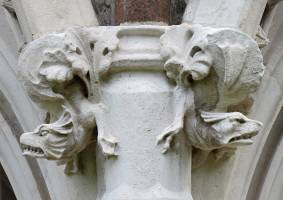
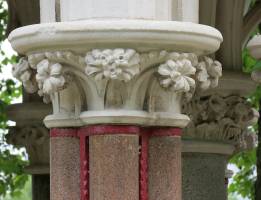
The main reason given for the move was that Parliament Square was being redesigned along Classical lines (despite the Gothic buildings of Westminster Palace and Westminster Abbey dominating two sides of the Square), so a Gothic structure did not fit in the new design.
Other Parliamentarians were far more critical of the Fountain. Viscount Swinton thought the fountain ‘revoltingly ugly’ Earl Jowett opined that ‘Though we all desire to commemorate the great work of Buxton, it seems to many of us that it is an appalling way to commemorate a great man and his great work by re-erecting such an appallingly ugly structure.’ Edward Keeling, a particular opponent of the Buxton Fountain, felt that the local council might simply remove the Fountain quietly one night, and ‘if that can be done, I am sure nobody would complain if the Buxton Memorial Fountain were seen no more’. One debater is recorded as saying that ‘I am very glad that it is to be removed from the Square. I hope it will also be destroyed, unless somebody comes forward with an offer to take it away and re-erect it.'
Lord Rea was one of several objecting to the Fountain being moved to Victoria Tower Gardens and felt it should be further away. ‘As one who, like many others of your Lordships, enjoys these gardens, and lives rather near to them, I hope the noble Earl will see to it that this open space is not filled up with a large number of memorials. If this fountain is to be placed in a valuable open space I hope it may be placed at the far end, near Lambeth Bridge, where it will not impinge on the valuable open spaces in the centre of the gardens.’
Lower chamber, central column and vaulting, and carved lion head.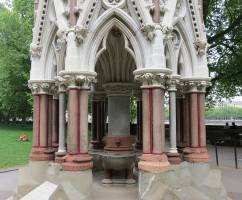
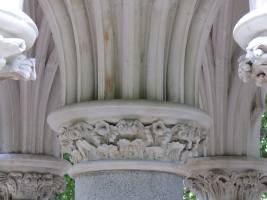
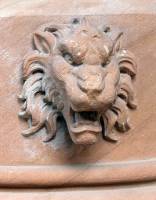
However, Ministers agreed with the highly vocal Anti-Slavery Society that the Fountain should at least stay close to the Palace of Westminster, given the importance of the Parliamentary battle for abolition of slavery, and that the Fountain ‘was erected by a Member of this House to other Members of the House who had taken part in and had won one of the greatest battles in Parliamentary history’ and hence the Victoria Tower Gardens site was confirmed.
The final word must be given to Lord Winster:
‘This memorial is not a statue. It is a memorial fountain which commemorates a noble deed, the reversal of a system which was very negation of humanity. It is associated with the name of a great man, the name of Fowell Buxton, and with the names of the Gurneys, the Hoares, the Barclays — names which have always been honourably associated with philanthropy and with the ideals of reform and humanity. It seems to me an extraordinary instance of our apathy to the part we have played in these questions that this Bill should provide specifically for the re-siting of the statue of Lincoln and forget the man whose act preceded the action of Lincoln.’
Aesop's Fables mosaics: some of the more familiar stories.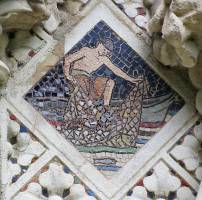
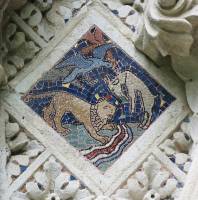
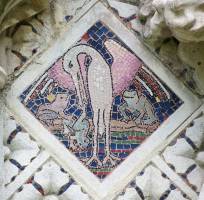
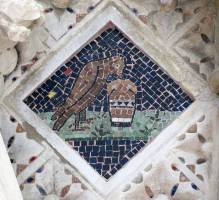
Thus the history. Now the art. Old and New London, an excellent textbook from the publishing house of Cassell, Petter and Galpin of the late 1870s, gives a fine description of the Buxton Memorlal Fountain which can be reproduced in full:
At the corner of Great George Street and St. Margaret's Churchyard [it's original emplacement in Parliament Square] is a conspicuous structure, with a spire and cross of imposing height, known as the Buxton Memorial Drinking Fountain. The base is octagonal, about twelve feet in diameter, having open arches on the eight sides, supported on clustered shafts of polished Devonshire marble around a large central shaft, with four massive granite basins. Surmounting the pinnacles at the angles of the octagon are eight figures of bronze, representing the different rulers of England; the Britons represented by Caractacus, the Romans by Constantine, the Danes by Canute, the Saxons by Alfred, the Normans by William the Conqueror, and so on, ending with Queen Victoria. The fountain bears an inscription to the effect that it is "intended as a memorial of those members of Parliament who, with Mr. Wilberforce, advocated the abolition of the British slave-trade, achieved in 1807; and of those members of Parliament who, with Sir T. Fowell Buxton, advocated the emancipation of the slaves throughout the British dominions, achieved in 1834. It was designed and built by Mr. Charles Buxton, MP, in 1865, the year of the final extinction of the slave-trade and of the abolition of slavery in the United States." Mr. S.S. Teulon was the architect, and the fountain was erected at a cost of about £1,200.’
Engraving of the Buxton Memorial showing the statues.
As mentioned at the top of this page, the eight small bronze statues, which were by the sculptor Thomas Earp, were stolen, disappearing in the 1960s and in 1971, and although replaced with new casts in 1980, I believe in resin rather than bronze, these also were taken. The engraving in London Old and New clearly shows the small statues (you will need to click on the picture to enlarge and see them). The other damage to the Fountain is slighter: replacement of the commemorative plaque, minor damage to a few of the mosaics, and the crumbling away of several of the small gargoyle dragons, and after some conservation, the memorial has been returned as closely as possible to its original state.
As we look at it from some little distance, it is in three stages, then. The lower part, say a quarter of the overall height, consists of the pale stone base and the clustered red granite columns, with a central column to give the internal vaulting which is not apparent unless close up to the monument. These pillars support the second stage, being the mass of white stonework forming the pointed arches, the decorated summits, and the surviving bases of the statues, giving a castellated effect all the way round. Each of the eight arches has above it on the narrow gable a trefoil within a circle, with central mosaic work, and three narrow triangles or spandrels of further mosaic; between these pointed gables are pairs of diamond-shaped mosaics all the way round. All of these mosaics are very small.
So much for the lower half of the monument, with its two stages; we could imagine the monument existing as a tower without the upper stage of the tall pointed roof, which in height is a little over half the total elevation. The upper half of the structure is a colourful spire with various repeating decoration in blue, torquoise, pink, green, and other favoured pastel colours, apparently at least in part being enamelled metal rather than tile, though the viewer cannot get close enough to confirm this by eye. At the very summit, a crocketed metal point supporting a decorative crucifix; little leafy designs in cast metal are on the projecting spines of the steeple lower down.
Three pairs of the gargoyle monsters.
The sculpture, such as survives, consists of decorative elements:
- The capitals of the pillars, which in typical High Victorian style, are carved in a variety of leafy and floral designs, some most appealing, though not of the fineness of the floral sculpture on buildings by Alfred Waterhouse.
- The crocketing on the tall gables includes simple ball-shaped bundles of decorative foliage, rather simply rendered, given the soft stone and their exposed position, and reminiscent of medieval ecclesiastical ball sculpture.
- At the bases of these gables are pairs of gargoyles, in the form small dragons and other grotesques. These are extremely spirited, and positioned at convenient height to attract the attention of the viewer, they form a real feature of the monument.
- And above the granite bowls of the fountain itself, on the base of the central shaft, are four carved snarling lion heads. (If you like lion head carving, there are lots of examples on this page).
The Mosaics
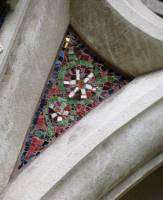
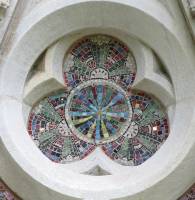
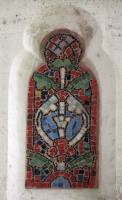
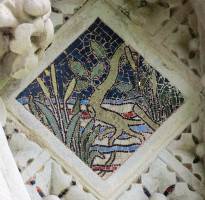
Differently shaped mosaic panels.
The mosaic panels really are very small, wilfully so, which we can likely put down to Teulon, so that they are only really noticeable close up. Even close to, their height and their sunken positions between stone means that pictures upon them must be very simple to be seen, and the mosaicist has chosen to reduce their subjects to the emblematic rather than anything approaching artistry. One little scene seems to refer to the emancipation of the slaves, with a slave apparently having his chain struck off - see picture at top of page. The others, however, seem in the main to be scenes from Aesop’s Fables (see further up page), which is an appropriate source of decoration given that Aesop was himself a slave, and the fables have moral and ethical points to make. Others of the panels have floral or purely decorative motifs. Where there are animals or persons shown, there is a thin border of black to emphasise the outlines, but on this small scale there is almost no attempt at shading, bar the wings of the stork in the picture showing The Frogs who wanted a King.
The actual mosaics are Italian smalti, presumably originating from the workshops of Salviati in Venice, but the setting, with thick grout between them, is not how the Italians would generally work, as it reduces the glitteriness and bright effects of the mosaics that close packing them gives. More on Victorian mosaics in London on this page.
This page was originally part of a 'sculpture of the month' series, for June 2015. Although the older pages in that series have been absorbed within the site, if you would wish to follow the original monthly series, then jump to the next month (July) or the previous month (May). To continue, go to the bottom of each page where a paragraph like this one allows you to continue to follow the monthly links.
Other sculptural fountains, at Whitechapel // in Hyde Park // and in Green Park
Parliament Square statues // London sculpture // Sculptors // Mosaics
Visits to this page from 1 Jun 2015: 9,143